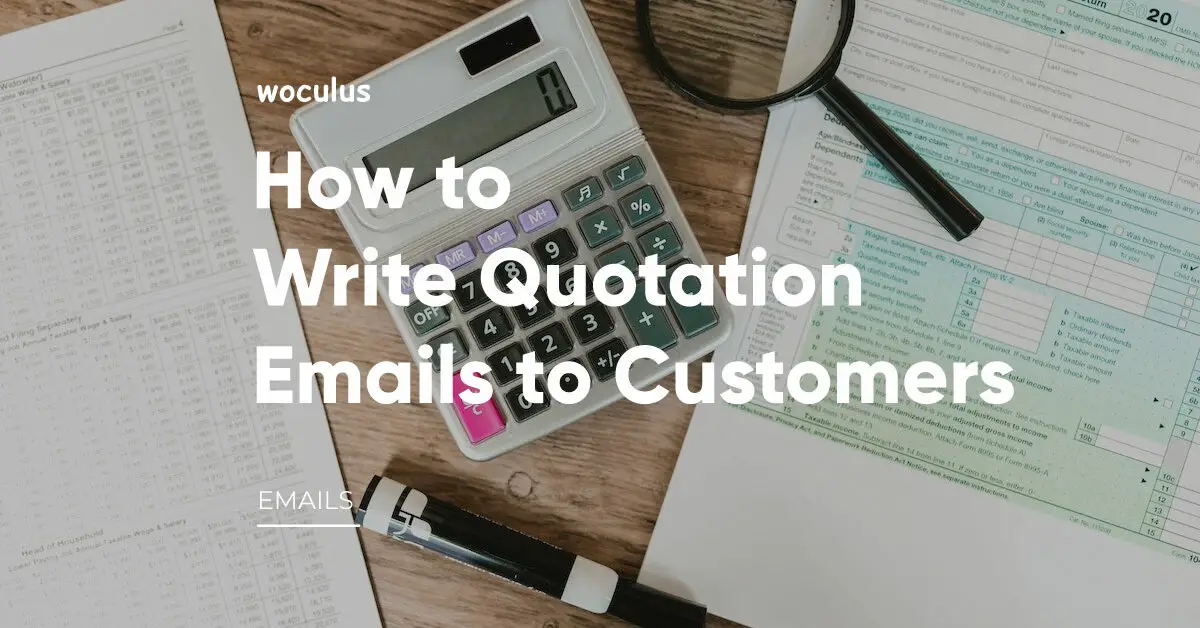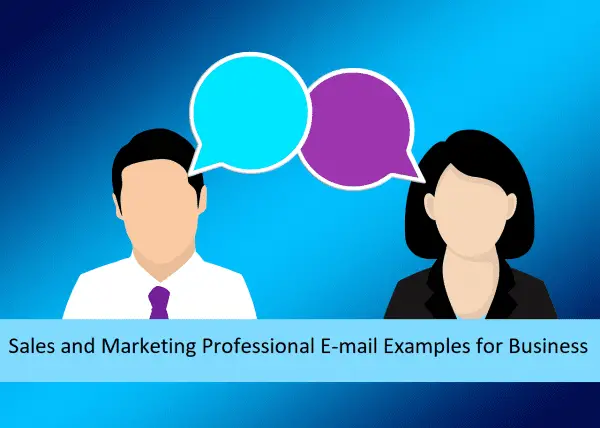Whether or not your quotations accomplish the intended goal depends in large part on how well-written they are. Everything you need to know about writing quotations in emails will be covered in this post.
Requests for Quotations (RFQ) were traditionally published in print media or sent out by formal letter to organizations to submit the requested quotations. This entire process took so much time but with email services, the turnaround time on requesting and receiving quotations has been significantly reduced. Though the act of requesting a quotation and responding to a request for quotation are both referred to as “writing quotation emails” the requirements and considerations are quite different.
An email requesting for a price quotation or specifications from an organization is quite straight forward and can be easily accomplished using your existing knowledge of good email writing skills and etiquette. A request for quotation email simply:
- Introduces the requesting organization
- Clearly states the needed goods, services or quotations
- Provides some information/background on the need/request
- Provides any other relevant information or sets a timeline for feedback
- Ends with typical email pleasantries
Writing a quotation email in response to a request for quotation from a client is far more technical! Geoffrey James in his article “The Tricky Business of Giving Price Quotes” referenced sales guru, Michael Pedrone of www.salesbuzz.com and accurately pinpoints the challenges in responding to quotation emails. A client email requesting for a quotation could merely be “research”, the client may be asking other businesses or service providers to submit quotes and comparing prices, the requester may or may not be the key decision maker! With all these variables and uncertainties, merely responding to this request like any other email and just sending the requested information, would be disadvantageous to your business.
Mr. James suggests going the extra mile to call or email the requesting party, before responding with your quotation, to ask clarifying/qualifying questions in order to ensure you respond with a quotation that accurately meets their needs and projects your organization as the best fit for the job.
Here are some tips to keep in mind when writing a quotation email to a customer that has requested a quotation:
Clarify the Client’s Requirements and Respond to Them
Before writing a quotation email to any client study the request for quotation carefully and contact the client for any necessary clarification. Take the time to outline all the client’s requirements and identify your product/solution that meets their need.
The worst mistake you can make when responding to a request for proposal is to provide a quote that is unfit for the client’s purpose. Customers will often provide some information/background of what they need and why. Your ability to fully comprehend their desires and identify the product/solution that best meets their need communicates your expertise and competence to provide the required service.
It is never enough to simply send the client your price list. Your complete price list should be an attachment to the email but identify the best options for the clients specified needs/requirements and detail them in your email response.
Email Example for Writing Quotation Emails to Customers
For example, your organization is a software development firm that creates bespoke solutions for organizations. A school owner has sent you an email requesting your quotation to develop a website. She states in her email that she wants a website that people can visit to get information about her school and parents can use to complete the registration of their children/wards, check the reports/performance of their wards and make payments.
Responding with a generic email like the one below does not show an understanding of her needs and misses the opportunity to connect and create an impression on the client:
Sample of Poor Response
Good day (Name), Thank you for your interest in our solutions at Bespoke Solutions Inc. Kindly find attached our price list for website development. Regards A better response that shows an understanding of her needs is:
Sample of Good Response
Good day (Name), Thank you for your interest in our solutions at Bespoke Solutions Inc. Bespoke Solutions Inc. is a leading software development firm with an impressive track record creating responsive solutions to support organizational objectives. We offer a broad range of website development solutions. Please find attached our comprehensive price list. Our understanding of your need based on your request for quotation is that you need a comprehensive school management solution with e-commerce functionality plus front and back-end support to enable you to manage the entire client engagement and support process online. Our prices for developing such solutions include: - Basic site – (Price and description of components) - Basic site plus e-commerce- (Price and description of components) - School management system – (Price and components) Please do not hesitate to contact us for any additional information/ clarification. Warm regards Annalie Smith Bespoke Solutions Inc.
Ensure all Preferences and Requests are Factored In
Pay attention to conditions and service preferences mentioned in the client’s request for quotation and how such requests may affect your prices. An example of some preferences to watch out for include:
Time Constraints: What is your typical turnaround time on delivery, installation or execution of your solutions? What is your standard operating procedure when a client requests a shorter time frame?
Holidays/Weekends: Do you work on weekends and holidays? Do you charge extra for weekend and holiday deliveries/jobs?
Additional Features: As seen in the example above, if your product/service can be customized or features can be added on, clearly capture the various prices for each feature.
Make Your Response Client Specific
Resist the temptation to take the shortcut of editing old emails or copy-pasting content to send out to customers. When writing a quotation email, personalize the content for the specific client. Use the opportunity to demonstrate your expertise in your field or an understanding of the client’s business or industry. Consider all alternatives and options that can help the customer achieve their objectives as captured in their request for quotation, and demonstrate your knowledge by recommending solutions or options not captured in the original request.
By taking this consultative approach and demonstrating your understanding of the customer’s needs and business, you set yourself apart from your competitors.
How to Write a Quotation Sample Email
This section of this article will discuss how to write a quote for a job or service you render. We will cover everything you need to know to write a quotation sample to get approval.
Introduction
This is one of the most important parts of your email as it sets the tone for the rest fo your email. It explains the email and gives the client a taste of what to expect from your quotation.
This section should begin with you greeting the client. When greeting the client, do not make the mistake of addressing the email to literally anyone in the company. Ensure it is personalized.
Provide Context
This section of your letter ties into your introduction and takes it a step further by providing context to what the rest of the email is about. It should also mention anything the client should expect before the actual quote.
Present the Quotation
This is easily the most important part of your email. It should clearly list everything about the quotation for the services you’re rendering. This means:
- A list of the products or services.
- Prices of the products or services.
- Available discounts or tax information
- Payment terms and options
- Other relevant information related to the quote.
Call to Action
A call to actions tells the recipient what you expect them to do after reading your quote. Depending on the nature of your business and preferred mode of communication, you can ask the client to schedule a call, book a meeting or reach out to you to continue the conversation.
Also, mention that they can reach out to you if they have any questions or inquiries.
Closing
Thank the recipient for their time and consideration and sign off with a polite closing remark and your name.
Sample 1. Quotation Email to Make a Quote for A Client
Subject: Quotation for [Product/Service] Dear [Client’s Name], Thank you for your interest in our [name of service/product]. Please find attached our quotation, and information concerning the timeline, the scope of work, and the pricing for the project. We have the utmost confidence that our solution will fulfill your requirements and surpass your expectations.We pride ourselves in providing high-quality products/services and offering our clients the best value. If you have any questions or concerns, please do not hesitate to contact us. Thank you for considering our proposal. We look forward to working with you. Best regards, [Your Name] [Your Title] [Your Company Name]
Sample 2. Quotation Email to Write a Quotation for Services
Subject: Quotation for [Services] Dear [Client’s Name], For the services you requested, please find our quotation attached. Our tailored solution, along with competitive price, will, in our opinion, satisfy your needs. If you have any queries or would want to discuss your project, our team is always available. We look forward to the opportunity to work with you and deliver outstanding services that help you achieve your goals. Thank you for considering our proposal. Best regards, [Your Name] [Your Title] [Your Company Name]
Sample 3. Quotation Email to Write a Quote for A Job
Subject: Quote for [Job/Project] Dear [Client’s Name], Please find attached our quotation for your [Job/Project]. We have taken into account all of your requirements and believe that our pricing is competitive. Our team is highly experienced and committed to delivering quality work on time. Please get in touch with us if you have any inquiries or worries. We would be honored to work with you on this project and look forward to hearing from you soon. Best regards, [Your Name] [Your Title] [Your Company Name]
Conclusion
Be professional and proactive when writing quotation emails to customers. Your ability to present your quotation in a way that demonstrates your understanding of your customers’ needs and the competence of your organization to deliver will set you apart from the competition regardless of the actual price of your goods/service relative to that of your competition because ultimately smart individuals and organizations are looking for quality and value, not just low prices.
Check out more Email Templates and Samples for Writing Quotation Emails to Customers







